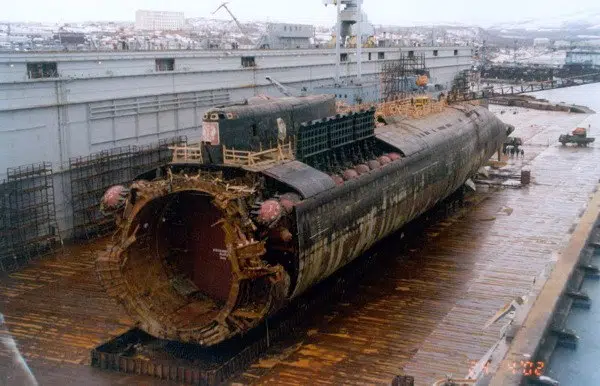Story of the Kursk Submarine Disaster – Mysterious & Horrific Maritime Disaster
There have been such maritime accidents in the past that have surpassed human capability to fathom the consequence of an untoward disaster. The causes of each accident could have been different, and the reasons could have been many, but the aftermaths have always been drastic and horrifying. The Kursk disaster is slotted on top of a huge list of such catastrophes.
The Kursk Submarine Disaster Story
The Russian submarine Kursk took its name from the city of Kursk, where the battle of Kursk was fought. This battle which took place in 1943, is regarded as the biggest warfare in the army combat tanks.
The importance and the need to understand the Kursk submarine disaster is not just because of the mishap that occurred but also because of the very nature of the naval vessel and the theories that followed its sinking in the Barents Sea on the 12th August 2000, 11.28 am as per the local Russian time.
Submarine Kursk was a nuclear submarine, and from the dwindling Russian military point-of-view, its relevance to asserting Russia’s dominance in terms of nuclear power was enormous. However, what was supposed to be a routine Russian naval exercise turned out to be the worst nightmare for the highly sophisticated Russian submarine members, categorised under the K-141 cadre, which exploded and perished in the deep blue sea, killing everyone on board.
The 118 crew members died on the Oscar II Class submarine constructed in 1994 and assigned to the Russian Northern Fleet. Per the navy officials, the submarine was not carrying nuclear warheads. Hence there could be no radiation leakages. The Rescue operation continued for days, and other nations like Britain joined it. However, nobody could establish a radio connection with the ill-fated submarine. Rescue efforts were hampered by icy waters, stormy weather and poor visibility.
The submarine sank after two blasts and sank only 350 feet below the surface. 23 crew were able to take refuge in the rear compartment and waited for help. However, it was too late. When the Norwegian divers opened the compartment, they were found dead, probably due to carbon monoxide poisoning.
The disoriented Russian navy command waited for many hours before launching a search and rescue and even turned down offers of western assistance. They sent Russian mini-submarines who failed in the task. The incident shook the nation, and President Vladimir Putin was criticised for his inappropriate handling of the rescue effort.
Post the incident, some of the various theories that were raised can be listed as follows:
- A retired Russian Admiral raised speculation that the country’s worst post-soviet naval catastrophe occurred as a faulty torpedo belonging to the US had collided with Kursk, causing the dually-pressurised hulls of the submarine to explode. These speculations arose from the fact that the western submarine was also damaged by the powerful explosion and sent a distress signal. The Russian Media reports highlighted that three US submarines were spotted near the area where the disaster happened.
- While Moscow accepted the unproven claim of the NATO Submarine, the US officials declined to accept the charge that a British sub was responsible for the accident.
- The second theory propounded was about the submarine colliding against the seabed, which caused the weapons kept inside the submarine to explode, leading to a casualty of a mammoth proportion.
However, the most concrete and highly substantiated theory is using inferior quality propelling fuel in the submarine torpedo, triggering an explosion. At the same time, regular mock military activities were being carried out. The usage of Hydrogen Peroxide in the torpedo contained in the submarine has been deemed the primary major culprit, setting off an explosion leading to another explosion of even higher proportions. In this context, it must be noted that the British navy had banned Hydrogen Peroxide from being used as a liquid propelling fuel because of its explosive, combustible, and volatile nature.
As per the other military vessels, the consensus on the timeline of the casualty settled at two explosions occurring within a time gap of two minutes between them. The impact of both explosions ranged in the trinitrotoluene(TNT) force scale, with the first explosion releasing around 100-250 kg worth of TNT force and the second releasing about 3-7 tons of TNT force.
When measured on the Richter scale, the density of the first explosion came to 2.2 while the second explosion thickness density was about 3.5 to 4.4. When the submarine exploded, 95 members of the 118-man crew died immediately while the remaining 23 battled for their lives for nearly 24 hours in an inner room before succumbing to a horrifying death.
The force and impact of the explosions on the submarine for quite a while led to fears about a looming nuclear disaster. But these fears were soon put to rest as no abnormal nuclear activity was carried out on the submarine, and the nuclear reactors were shut.
The most striking factor about the incident is the Russian officials’ continued denial of accepting the enormity of the situation. They shunned rescue help from the United Kingdom and the United States. This outright refusal to accept the much-needed help that could have saved the 23 lives aboard the ship portrayed the Russian government negatively.
When the Russian government finally relented, and foreign rescue aid was allowed to be carried out five days following the accident, it was too late for the crew of the Kursk submarine. All 118 members had perished.
Their death was quite poignant, for these men often went without a decent salary for their dedicated naval services. To reach the once-attained pedestal of military supremacy and unwanted pride, innocent lives were sacrificed. The submarine was finally salvaged from the seabed, and its remains were raised by the Dutch salvage company a year after the disaster in 2001. Out of the 118 dead, the bodies of 115 members were recovered, providing a much-needed consolation to the crew’s families.
More than a decade has passed since the Kursk disaster took place. People worldwide might have forgotten the submarine Kursk, but for the parents and other loved ones aboard the submarine, it would be a date that could never be overlooked. The Kursk submarine and its crew might have gone forever, but the thought of whether the disaster could have been prevented will always linger on.
Frequently Asked Questions
1. How long did Kursk crew survive?
According to experts, 23 crew members took shelter in the 9th compartment and survived for six to eight hours. However, when oxygen levels dropped, they tried to change a potassium superoxide chemical oxygen cartridge, but it fell into the oily waters and burst.
2. What caused the Kursk disaster?
The government report mentioned that the submarine was sunk by a torpedo explosion which was caused by high-test peroxide, a concentrated form of hydrogen peroxide, that leaked from the cracks of its casing. The fuel in the torpedo was inexpensive and highly combustible.
3. Were the bodies of the crew members recovered?
After much effort, the search and rescue teams recovered everything from the seabed except the submarine’s bow. They also brought the remains of 115 sailors who had gone down with the sub. They were honourably buried in Russia.
4. Was the Kursk ever recovered?
5. How were the victims’ families compensated?
You may also like to read-
- The Deadliest Maritime Disaster: Sinking of MV Wilhelm Gustloff.
- The Biggest Nuclear Submarine in the World – Typhoon Class Submarines
- Understanding Structure Design of a Submarine
- Top 10 Books On Submarines
- Submarine Design: Unique Tanks On a Submarine
Disclaimer: The authors’ views expressed in this article do not necessarily reflect the views of Marine Insight. Data and charts, if used in the article have been sourced from available information and have not been authenticated by any statutory authority. The author and Marine Insight do not claim it to be accurate nor accept any responsibility for the same. The views constitute only the opinions and do not constitute any guidelines or recommendations on any course of action to be followed by the reader.
The article or images cannot be reproduced, copied, shared, or used in any form without the permission of the author and Marine Insight.
Do you have info to share with us ? Suggest a correction
Subscribe To Our Newsletters
By subscribing, you agree to our Privacy Policy and may receive occasional deal communications; you can unsubscribe anytime.





Back in 2001, I first saw the picture of the woman tossing out roses to the sea in tribute to the sailor that perished in the Kursk disaster. I wanted to know about the story of the picture. Was the woman related to one of the sailors that perished? Who was she? Is she still alive? My heart was saddened by the picture of the lady and wish her well. Wherever she is. Please let me know of any information if you can.
Thank You.
Dwayne Tamaya